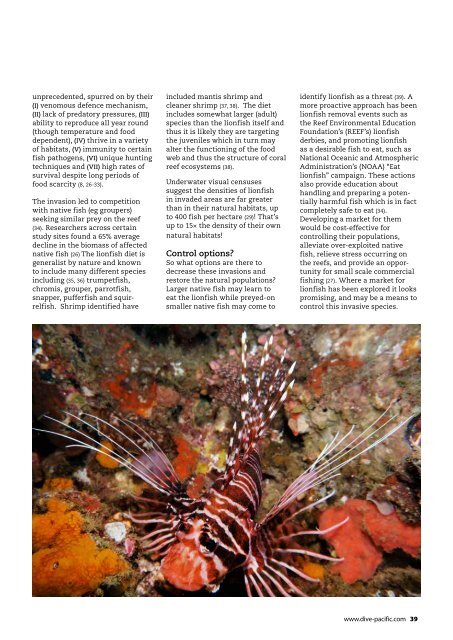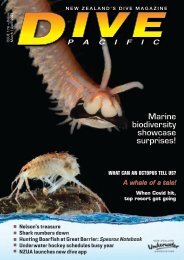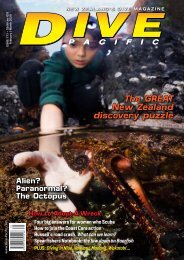Dive Pacific Iss 171 Oct- Nov 2019
New Zealand's dive magazine featuring in this issue: Shooting big sharks, up close; Spearfishing at night!; Remembering a great Kiwi dive pioneer, Wade Doak; Forgotten Vanuatu wreck's claim to fame; The invasive Lionfish - in depth, plus all our expert columnists
New Zealand's dive magazine featuring in this issue: Shooting big sharks, up close; Spearfishing at night!; Remembering a great Kiwi dive pioneer, Wade Doak; Forgotten Vanuatu wreck's claim to fame; The invasive Lionfish - in depth, plus all our expert columnists
Create successful ePaper yourself
Turn your PDF publications into a flip-book with our unique Google optimized e-Paper software.
unprecedented, spurred on by their<br />
(I) venomous defence mechanism,<br />
(II) lack of predatory pressures, (III)<br />
ability to reproduce all year round<br />
(though temperature and food<br />
dependent), (IV) thrive in a variety<br />
of habitats, (V) immunity to certain<br />
fish pathogens, (VI) unique hunting<br />
techniques and (VII) high rates of<br />
survival despite long periods of<br />
food scarcity (8, 26-33).<br />
The invasion led to competition<br />
with native fish (eg groupers)<br />
seeking similar prey on the reef<br />
(34). Researchers across certain<br />
study sites found a 65% average<br />
decline in the biomass of affected<br />
native fish (26) The lionfish diet is<br />
generalist by nature and known<br />
to include many different species<br />
including (35, 36) trumpetfish,<br />
chromis, grouper, parrotfish,<br />
snapper, pufferfish and squirrelfish.<br />
Shrimp identified have<br />
included mantis shrimp and<br />
cleaner shrimp (37, 38). The diet<br />
includes somewhat larger (adult)<br />
species than the lionfish itself and<br />
thus it is likely they are targeting<br />
the juveniles which in turn may<br />
alter the functioning of the food<br />
web and thus the structure of coral<br />
reef ecosystems (38).<br />
Underwater visual censuses<br />
suggest the densities of lionfish<br />
in invaded areas are far greater<br />
than in their natural habitats, up<br />
to 400 fish per hectare (29)! That’s<br />
up to 15× the density of their own<br />
natural habitats!<br />
Control options?<br />
So what options are there to<br />
decrease these invasions and<br />
restore the natural populations?<br />
Larger native fish may learn to<br />
eat the lionfish while preyed-on<br />
smaller native fish may come to<br />
identify lionfish as a threat (39). A<br />
more proactive approach has been<br />
lionfish removal events such as<br />
the Reef Environmental Education<br />
Foundation’s (REEF’s) lionfish<br />
derbies, and promoting lionfish<br />
as a desirable fish to eat, such as<br />
National Oceanic and Atmospheric<br />
Administration’s (NOAA) “Eat<br />
lionfish” campaign. These actions<br />
also provide education about<br />
handling and preparing a potentially<br />
harmful fish which is in fact<br />
completely safe to eat (34).<br />
Developing a market for them<br />
would be cost-effective for<br />
controlling their populations,<br />
alleviate over-exploited native<br />
fish, relieve stress occurring on<br />
the reefs, and provide an opportunity<br />
for small scale commercial<br />
fishing (27). Where a market for<br />
lionfish has been explored it looks<br />
promising, and may be a means to<br />
control this invasive species.<br />
www.dive-pacific.com 39













